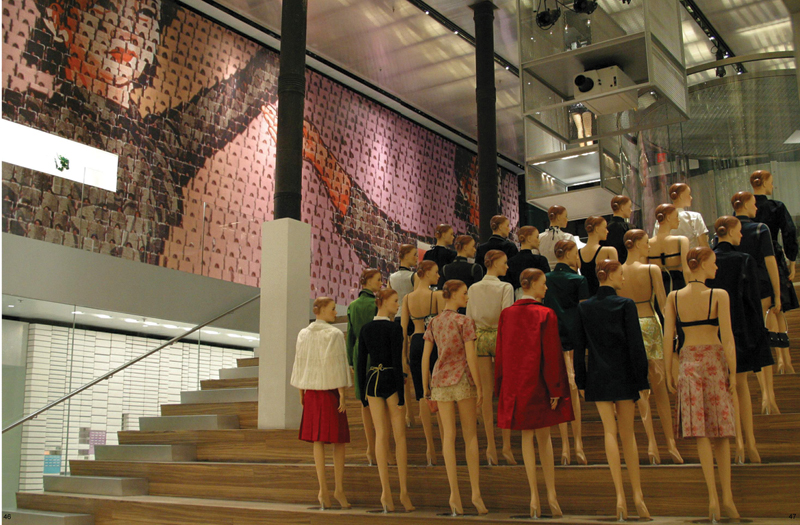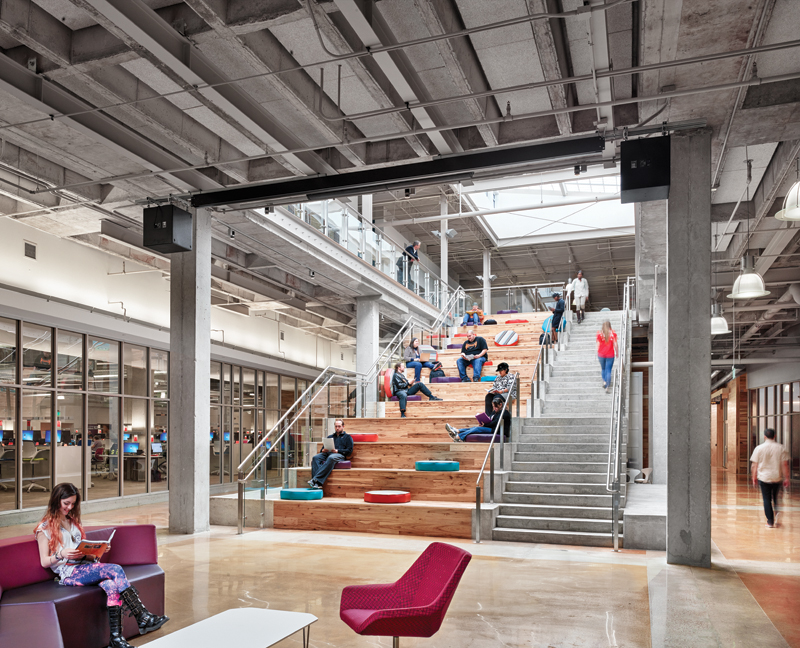A Meme for Our Time
What is a social stair? Remember back in 2001, when OMA/Koolhaas and Scheeren completed the Prada Boutique (now called Prada Epicenter) on lower Broadway in Soho? It features an amphitheater-like stair leading from the ground floor down to the basement. This stair can be used as a stair, taking you from one level to the next. It can also be used as bleacher-like seating. And when it is not accommodating seated human beings, the amphitheater part of the stair can be peopled with ranks of mannequins outfitted in Prada fashions. Though not the first of its kind, the Prada stair is the archetype of the 21st-century social stair. The social stair connotes a style of 21st-century sociability: cool; hip; spontaneous; diverse, yet connected; and youthful. As such, it has been transformed into a symbol: an icon of collective identity that suggests it has the power to make you cool, hip, awesome (and maybe even young) — just by being in its presence. The 21st-century word associated with this phenomenon of implied magical bonding is “meme” (rhymes with “mean”). My authoritative source on 21st-century forms of knowledge, Wikipedia, tells me that “meme” means a unit of conduct that you can internalize and imitate in order to represent yourself to others as embodying the desirable associations — cool, hip, awesome, young — affiliated with the meme/form. So now you know: The social stair is a magical meme. It possesses the power to confer a social identity, linking you to a community that you want other people to see you as belonging to.
The Wikipedia entry on memes has a whole section on architectural memes, an indication of the potency that buildings possess to shape the attitudes, opinions, and conduct of the people who occupy, or simply pass by, them. The Wikipedia entry also identifies the foremost theorist of architectural “meme-ology” as Nikos A. Salingaros, professor of mathematics at The University of Texas at San Antonio, and author of “A Theory of Architecture” (2006).
Houston, in the past four years, has experienced a population explosion of high-profile social stairs. The expansion and reconstruction of the University of Houston Student Center South (2015, EYP and WTW); the Midtown Arts and Theater Center Houston (2015, Studio RED and Lake|Flato); the Moody Center for the Arts at Rice University (2017, Michael Maltzan); the Glassell School of Art of the Museum of Fine Arts, Houston (2018, Steven Holl and Kendall/Heaton Associates); and the Kinder High School for the Performing and Visual Arts (2019, Gensler) all have public spaces configured around social stairs. Do the people who frequent these buildings actually hang out on the social stairs, embodying the forms of contemporary sociability depicted in architectural renderings? Or is this even a relevant question? Doesn’t the very existence of the social stair demonstrate that the building comes equipped with the necessary spaces for shaping cool, awesome, etc., subjects and bonding them into a community?
In his book “The Architecture of Neoliberalism: How Contemporary Architecture Became an Instrument of Control and Compliance” (2016), the British architectural historian and theorist Douglas Spencer decodes such memes as the social stair; long refectory-like communal work tables; internally exposed trusses, ducts, tile block walls, and concrete floor slabs; and interior glass partitions to argue that these are not simply constituents of a currently fashionable style of architecture but the material and spatial building blocks of a social system based on the exaltation of economic markets. What Spencer finds notable about the effort to shape people’s (and especially architects’) self-conceptions and their ideas about community is how often Neoliberalism operates through soft means (and soft memes) — architecture, fashion, advertising images, architectural renderings — rather than through rules, creeds, and the formation of political or religious belief structures. The rhetoric of self-direction and workplace democracy, the absence of hierarchy, the ability to bring your pet to work — are visually portrayed in memetic images of happy, attractive, racially and ethnically diverse groups of young people working at their laptops or texting on their cellphones, spontaneously generating innovation even as they break from their co-work perches on social stairs to grab a healthy fusion snack at the nearest food truck corral. The social stair is a spatial instrument for shaping opinion and winning acquiescence to lifeways meant to support a political system that promotes economic competition as a form of communal well-being liberated from political regulation.
The “plazas” of 1960s office buildings; reflective glass curtain walls on 1970s office buildings; the skylit, air-conditioned “atriums” of 1980s office buildings; “contextually” cladding 1990s’ commercial and institutional buildings with banded brick and cast stone finishes are past architectural memes propagated by architects that, in their day, seemed to materialize access to new and better collective realms — until memetic overproduction resulted in a decline in market value, and these emblems of community belonging lost their bonding power and were relegated to the ash heap of embarrassing stylistic clichés. Academic and professional discourse since the rise of modern architecture has demonized the phenomena of style and fashion. Suppressing critical discussion of the operation of style and fashion has enabled architects to participate in the dissemination of fashionable styles as long as they don’t acknowledge what they’re doing. Outing the social stair as an exemplar of style-and-fashion-dissemination externalizes the mechanisms through which architects encode buildings with emblems of a desired community to which they wish to be seen to belong, reproducing identifying materials and spaces aimed at affiliating a building with a community of belonging that exerts immense attractive power until some new and more compelling symbol of belonging supplants it, flipping the old symbol into an icon of insufferable un-cool.
Architects possess the power to invent, and reproduce, constructions and spaces that come to operate socially as symbols of community belonging and identity. Memes, in giving form to what a community might look, sound, and feel like, encode and transmit this desire for being seen to belong to such a community. As a meme for our time, the social stair is an architectural icon of Neoliberalism, spatially celebrating the personal liberty that proponents of deregulated markets assert such markets produce, while evading questions about affordable housing, health care, education, immigration, social mobility, and climatic repercussions that, sooner or later, will confront the diverse, attractive, effortlessly affluent youth who people these architectural constructs: The social stair is an imaginative stand-in for the communities of love, acceptance, approval, and success to which we, too, yearn to belong. The paradox of memeticization is that the architectural symbol can never become a surrogate for the community it symbolizes. It is frustration induced by the failure of architecture to perform magically as a surrogate for community that leads to the judgment that architectural symbols have devolved into mere stylistic clichés and that it was fashion, rather than some nobler ideal, that led misguided architects astray. The social stair has not yet rounded the corner into meme degradation. But the fashion cycle is inexorable. Once the gods of cool retract their blessing, the social stair will stand exposed as a false idol, a human construct that promised much but could not sustain the utopian expectations it initially aroused.
Stephen Fox is a fellow of the Anchorage Foundation of Texas.







